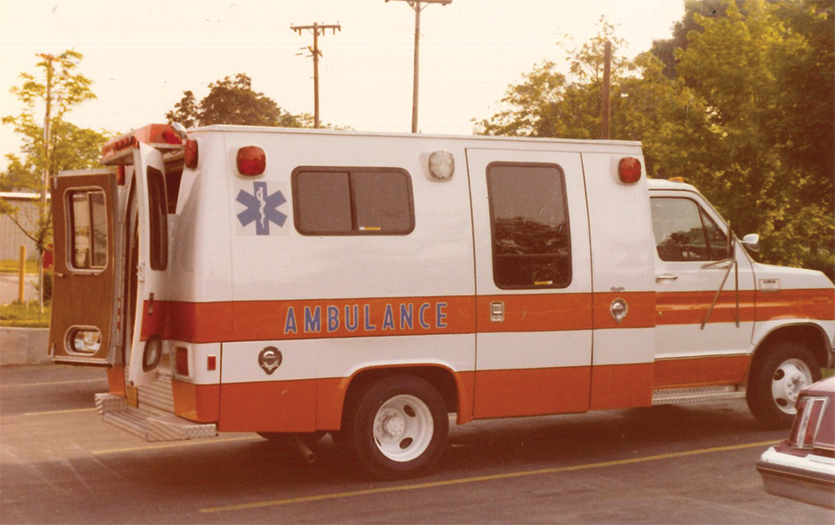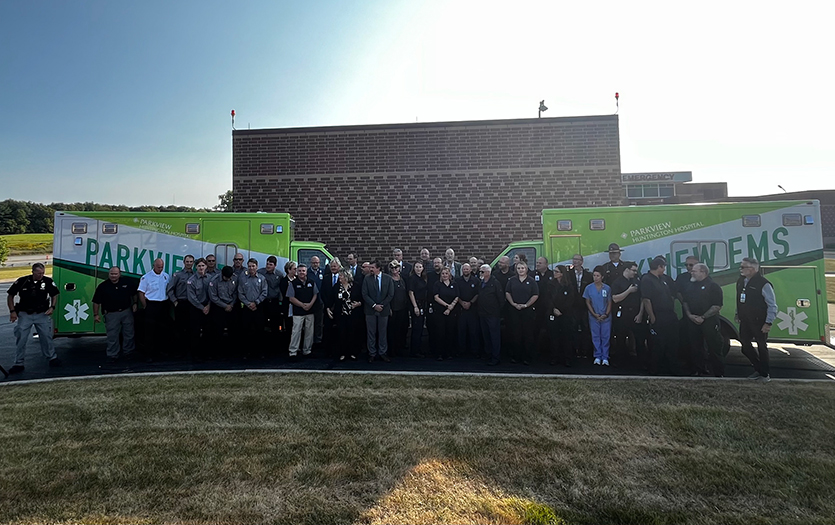
On September 1, 1974, EMS services were introduced in Huntington County, though training had been underway for weeks. Five decades into the prehospital offerings, those closest to the program came together to reflect on the early days of these services and how things have changed over time. Read highlights from our conversation with Parkview Huntington EMS for Huntington County experts, Jeff White, EMS supervisor, advanced EMT, EMS; Brian Miller, advanced EMT; Steve Caley, retired paramedic; Carla Gebert, BS OLS/EMTP, manager, Parkview EMS in Fulton, Huntington, Wabash, Whitley and Kosciusko counties; Doug Selig, vice president, Patient Care Services, Parkview Huntington and Parkview Wabash hospitals; and Sonya Foraker, finance leader, Parkview Huntington Hospital and Parkview Health ED, EMS and Flight service line.
Beginnings
Early on, the emergency medical technicians (EMT) had to pull “side duty” as aides and orderlies at what was then Huntington Memorial Hospital. After 40 hours of training in the hospital, they could work on the trucks, getting them prepped for patients and learning how the ambulances and their accessories worked.
“Originally, we worked eight-hour shifts,” Steve said. “We were based in the ER and did our own dispatch. There’d be four of us – three assigned duties throughout the hospital, wherever they needed us that day, and one functioning as a dispatcher for the EMS. We had a seven-digit phone number. We’d take calls from people throughout the county. Anywhere other than the 356 exchange actually had to make a long-distance call to get an ambulance.”
Since Huntington County was largely rural, there were many homes that didn’t have house numbers at the time. “We’d get dispatched to Rural Route 7, or someone would say, ‘It’s two houses down from Smiths’,” Carla recalled. “We laugh about it now, but most of our calls were to the country, and it helped to know where people lived.”
Vehicles
When the Huntington EMS program began, they had two vehicles, a 1974 Dodge Tradesman van with a high top and an old Chevy. The team transported the first patient on September 2, 1974.
“A few years after we started, Mr. Bailey, who ran Bailey Mortuary, donated a Cadillac hearse,” Steve said. “It was just for transport.”

In the early days of first responder programs, Huntington was the only county in the state, and nearly the nation, that had a rescue truck run out of the sheriff’s office. “Most of us on the original crew were county sheriff reserve as well,” Steve said. “We had to use crowbars and physical force to pry people from vehicles. It’s amazing to think about how we adapted to scenarios back then, compared to the training and equipment medics have today.”
LeMoyne Drabenstot, who was involved in getting the Huntington prehospital program started, often responded to motor vehicle crashes and had trouble getting the victims out of the cars. He worked with the Southside Business Association to secure van and hearse tools designed for rescue. “The first jaws of life felt like [it weighed] 400 pounds!” Carla said.
The team reflected with some amusement over the humble beginnings of their maintenance and vehicle care. “When we first started, we just parked the ambulances outside,” Steve said. “I can remember in the winter, we put cardboard on the windshield and put the windshield wipers up to hold the cardboard in place.”
Eventually, the hospital built a combination garage/storage building, which helped, but required the team to run out from the hospital when a call came in. In time, EMS got a garage located conveniently next to the ER.

As for the style of medical transport vehicles, “I feel like it’s come full circle,” Steve said. “When I started, it was high-top vans. Then one of the big manufacturers started pushing the big boxes on the van chassis, and the idea of being able to remount that was one of the big sellers. Then we went to the box type to give us more room to work in the back of the truck. And now it seems like we're back to the sprinter vans. The interior is much better, though, than it was in the old days. The equipment is smarter and lighter.”
Training
Doug pointed out that Steve was a pioneer when it came to first responder training. In 1974, Huntington was among the earliest adopters of an EMS program. This was a massive benefit to residents in the area, but it also meant that there weren’t many examples for how to structure and train a team. With no guidelines, standards or best practice models, Steve and the early Huntington team had to develop them as they learned.
“We were really writing best practices for prehospital care in our community,” Carla said. “But also, for the state and the country.”
“And now we're reaping the benefits from those leaders like Steve and others, who came in and saw that vision and figured out what needed to be done prehospital,” Doug said.
The original team consisted of all basic EMTs. “Indiana didn't have a certification program at that time,” Steve said. “When the Indiana EMS Commission came along, they grandfathered all of us in, so we were nationally registered.”
.jpg)
In 1978, Northeast Indiana became one of the first regions to offer the Advanced EMT (EMTA) program. EMTs from Huntington, Whitley, Noble, LaGrange and Allen counties interviewed for the opportunity to attend a class in Fort Wayne. “This is where the whole idea of more advanced care came in – starting IVs, a little bit of cardiac care, etc.” Steve said.
Back then, EMTs had cardiac monitors and were trained to read an EKG, but they could do little in the way of treatment. But with the introduction of the paramedic program a little later, that changed. “Northeast Indiana, Huntington and Whitley were all very progressive in the care we provided in the field,” Steve said.
Steve worked for 20 years in the Huntington EMS program full-time. In 2005 he got his nursing degree, went part-time and finished his career with 23 years as a nurse. Throughout his time in the clinical field, Steve played a prominent part in implementing procedures first responders could perform on a scene to buy the patient and the care team at the hospital more time.
“We started Emergency Medical Dispatching (EMD) in the earlier years of the program,” Steve said. “It was developed by a doctor in Salt Lake City, Utah, Dr. Jeff Clausen. In the early days of EMS, we always used lights and sirens to get to the scene as quickly as we could. Dr. Clausen came up with a flip chart protocol for police, fire and EMS dispatch systems, where there were ten cards for the most common calls. For example, card 10 was for cardiac symptoms, and it had questions printed on the page that dispatch could ask. Then, based on the responses, agencies could adapt the response. It was a neat program in that it was flexible.”
Steve thought so highly of the program, he traveled around the country teaching it for Dr. Clausen for a number of years. “I have to think that saved a lot of lives,” Steve said. Now entirely computer-based, the EMD program remains a valuable tool for our first responders today.
Dispatch and coverage
In 1968, the city of Huntington was the first in the state to get 911 service. The 911 call could get fire and police, but you still had to call the seven-digit number to get EMS. “Another issue was, it was only for the city of Huntington,” Steve said. “In fact, initially if you had a 356 number, 911 wouldn’t work, so some areas still had to use our seven-digit phone number for EMS to get fire and police also.”
When the General Motors (GM) plant was built in Roanoke in 1986, the Huntington EMS team was the closest paramedic unit. “We had a connection at the time, Chris Newton, and he went into the Roanoke fire station. They were gracious enough to give us space inside their station so we could have quarters there. We built two bedrooms and a common room,” Steve said.
Flight
Early on, Huntington had a helicopter service called Pulse Flight in conjunction with Hooks Drugs, which owned the helicopter – a Bell Long Ranger. “We would take air medical calls,” Steve said. “They’d fly up to Huntington and we'd load the gear up, drive over and meet them behind the old family practice office.”
Steve admits the program didn’t go as smoothly as they would have liked, primarily because they couldn’t respond to scenes. Parkview Samaritan air medical transport became available in 1989.
“Samaritan provided a much better service,” Steve said. “But when we look back, Huntington was pretty groundbreaking when it came to helicopter services. Methodist Air landed in our hospital parking lot in 1978 to transport a patient and that was pretty new.”
Parkview
In 1996, Huntington Memorial Hospital began an affiliation with Parkview Health. With the move into a newly constructed facility on Stults Road in 2000, the hospital officially changed its name to Parkview Huntington Hospital, and thus, Parkview EMS serving Huntington County.
“One of the biggest changes that came from that was the resources to capital,” Sonya said. “Up until then, as a county-owned hospital, we were struggling financially in all aspects. So, aligning with Parkview and getting the technology and equipment needed to deliver great patient care was a boost for our community.”

That access to capital also made it possible for the EMS team to have a second truck on the south side of the county. “We’d wanted a truck there for a long time,” Brian said. “It was day truck, staffed for 12 hours, that offers quicker response times for patients on the south side of the train tracks.”
Changes
Over the last 50 years, Huntington EMS team members have seen a lot of change, from equipment to cardiac care to medications they can administer.
“Early on, all we could do was CPR and breathing for the cardiac arrest patient,” Carla said. “So, in time, being able to administer cardiac drugs, intubate and hold that airway, those shifts were huge.”
Overall, most agree that paramedicine technology has seen the greatest shifts.
“In the late ’70s, we got this 40-pound monstrosity of a defibrillator,” Carla said. “We’d carry that thing into someone’s house, and it wasn’t hands-free. You really had to look around to make sure nobody was touching the patient and that your hands were solely on the paddles. So, the advancements in technology on defibrillators alone is really amazing, all the way to the automatic defibrillator machine used today in fire departments, police, and public buildings.”
The group also reminisced about a 12-lead ECG machine that had to be plugged into the patient’s wall, and cots that had to be raised and lowered manually. Developments in portable equipment for first responders have helped reduce injury risk for team members and improve the delivery of life-saving care.
When it came to human resources, there’s been a lot of trial and error involved in finding the right shift arrangement. “We’ve tried so many staffing configurations, rest cycles and sleep quarter locations,” Carla said. A rested crew is imperative. In the ’70s and ’80s, the team responded to an average of 8 calls per day. Today, the team handles approximately 25 calls in a 24-hour period. From a safety standpoint, the increased call volume pushed EMS to move from 24-hour shifts to 12-hour shifts.
Advancements in technology, standardizing safety protocols and scene procedures, and considerations for team wellness have all led to better outcomes for all involved.
Community
In a smaller community, naturally, a lot of the residents know each other. This makes providing care particularly rewarding, but also brings an added emotional element.
“Anytime you're dealing with a friend or family member, it makes a call tougher to handle,” Steve said. “I remember back when my kids were starting to get their driver's license. Every time I heard a 1050 come in, and I was on duty, I worried.”
“You definitely didn’t go into it for the money,” Carla said. “I think we started out at $5/hour back then.”
Steve added, “I think all of us have a strong desire to help where and when we can.”
Milestone
When asked what this 50th anniversary means to the team, the room gave a unified, “We're old!”
“Jeff and Brian have been with Parkview Huntington EMS for 26 years as clinicians. I came first in 1987, when I was 22,” Carla said. “I was with Parkview Huntington from 1987-1992 the first time as an EMT and paramedic and then returned in 2009 as the manager. So, we’ve been around for more than half the program.“
There’s a strong thread of pride that runs through the Huntington EMS alumni, with good reason.
“We were progressive,” Carla said. “Everybody in the state knew Huntington. You’d hear about it at paramedic school. It was awesome for me to come back as a leader at Huntington because I got to see how far the program had come.” She also shared that the team passed along their best practices with others in the field, even at the state level. “It was incredible to have that kind of impact on prehospital care. Huntington was known for trailblazing and for setting that bar so high. The state commission would look to Huntington when setting standards. People at all levels wanted to see what we’d do next.”
“I think Huntington and Whitley were both very fortunate to have progressive medical directors in our services to help us set best practice and bringing in new concepts,” Steve said. “Huntington was very highly respected and others in the industry knew we were heavily trained.”
“I think the fact that the medical directors, Dr. Brown and Dr. Willard, had a vision made all the difference,” Carla said. “It would have been so easy to just do what everybody else was doing. There were no pictures. No internet. It was physicians and team members taking the time to do the training and push the program forward.

“I would also mention, it was one of the few programs, particularly in the early days, where the crew was almost half female,” Carla said. “There were so many women coming up through the ranks at Huntington, skilled paramedics, but the thought was they couldn’t be as strong in the field. When I came to Huntington in 1987, I learned and grew so much from great female paramedics and leaders like Claudia Patterson. She was “tough as nails” and had incredibly high standards, but she was an awesome teacher and mentor. She was a shift leader who worked hard and taught me so much.”
There was a shared sentiment of family among the medics, past and present. It’s these hearts dedicated to helping and the support of strong leaders that has made the last 50 years so impressive.
Congratulations to the entire Parkview EMS team for Huntington County team on five decades of dedicated service. And here’s to 50 more!



